Early Life

Magritte in 1899
Rene Magritte was born November 21, 1898, the eldest of three sons. The family lived in Chatelet from 1904 to 1917, except for two temporary stays in Charleroi and Brussels in 1913 and 1916. Léopold, his father, was a moderately successful businessman and his mother committed suicide in 1912. At the 1913 Fun Fair of Charleroi that he first met the one who would become his wife in 1922: Georgette Berger.
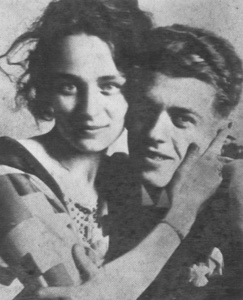
Rene and his muse Georgette
In an interview Michael Georis of the newspaper Le Peuple Magritte said "As a very young person, around six or seven years," Magritte answered. "I attended later the Athenaeum of Charleroi and I liked much to draw and paint. My mother had died when I was very young. My father liked my drawings, my painting... He was benevolent and encouraged my vocation."
René felt an artistic calling in Châtelet where he took his first lessons in art; Eugène Paulus, the well-known sculptor, must have been one of his teachers. The Magritte Museum in Brussels has a landscape circa 1910 that they claim is his first painting. The Magritte Catalogue Raisonné by David Sylvester and Sarah Whitfield show black and white reproductions of three paintings done by magritte in 1910; two are landscapes with a house (one of which is in the Magritte Museum) and one is a still life of flowers in a vase. According to John Paul Fostier: "In 1911 René completed his first great oil painting: "Chevaux dans une pâture" (Horses in a pasture) which filled his father's heart with pride."
Magritte's early impressionist works date back to 1915. The very first exhibition of works by René Magritte was held in the summer of 1915, in the "Château Bolle", rue de Couillet in Châtelet. This exhibition also displayed, among others, works by Albert Chavepeyer. In November 1915 Rene moved by himself to Brussels to study and pursue his artistic career. By 1916 the family followed his to Brussels and Rene intermittently attended classes at the Fine Arts Academy of Brussels until 1921 but took far less interest in what he was being taught than in the people he met there.
Another source says: "He began lessons in drawing around 1910 in Chatelet where his family had moved- his father was also a trader which lead to a nomadic lifestyle in search of money. Magritte's first painting, a Belgian landscape was done in 1910 and is on display at the Rene Magritte Museum in Jett, a suburb of Brussels." As a young man Magritte also wrote mystery novels (under the name Renghis- a combination of his first and middle names) and poetry. He also read mystery novels. Maybe that's why his artwork is... mysterious.
Rene became a fan of famous Fantomas film series in 1913 and 1914, which had been inspired by the novel by Souvestre and Allain. The Fantomas figure would become Magritte's alter ego and would influence many of his later paintings. In 1919 and 1920, Pierre-Louis Flouquet, a French artist living in Brussels, shared his workshop with René Magritte and he was introduced to cubists and futurists; Magritte also got acquainted with the Antwerps avant-garde.
While studying at the Académie Royale des Beaux-Arts, Magritte met many artists who would influence his style, amongst them were E.L.T. Mesens, Pierre Flouquet, Paul Delvaux and Piérre Bourgeois. In 1918 when Rene began work as a poster and advertisement designer for a wallpaper company at Peters Lacroix, he met the painter Victor Servranckx, who had already turned to non-figurative art. Magritte worked under the supervision of Servranckx and they had become friends and colaborators. In 1919 Magritte’s first exhibit displayed his creations in advertising, not in painting. He exhibited two ads: one for Sherlock and the other for Monnaie Butterfly. The trade fair was organized by Víctor Bourgeois and Aimé Declerq at the Belgian Galerie Centre d’Art, run by Pierre Bourgeois (see Portrait below). Together with Pierre and Victor Bourgeois, Rene started the journal (magazine) Au Volant in 1919, linking himself with the Belgian Dada movement. Magritte contributed drawings to the issues.
After lecture on the Dutch movement by abstractionist Theo van Doesburg titled De Stijl (The Style) in February 1920, Magritte began a series of paintings exploring those principles. Around the same time Servranckx and Magritte developed an artistic style based on purism and futurism they called Cubo-Futurist which in some ways was similar to Art Deco. Then in 1922 they wrote "Pure Art: A Defence of the Aesthetic." That same year (1922), he made one of the most important artist discoveries of his carreer in Giorgio De Chirico's pre-surrealist works (194-1918). Rene and his friend ELT Mesens were shown a reproduction of De Chirico's The Song of Love in Les Cahiers Libres and he was so moved by the image that it moved him to tears. This provided true inspiration Magritte decided to make each of his painting a visual poem; a quality he found present in De Chirico's works. [Magritte's Catalogue Raisonné by David Sylvester and Sarah Whitfield pinpoint the date when Magritte viewed De Chirico's The Song of Love to between the summer of 1923 and the end of 1923. Most sources give the date as 1922, some as late as 1925 when Magritte began employing a similar style.]
Magritte and Mesens were involved in many avant-garde political movements. Dada was a reaction against the politics that lead to First World War (1916) and remained a popular artistic movement until around 1924. Both men espoused Dadaism and shortly after they met in 1920 studied Marinetti's futurism pamphets. In late 1924 the Dada movement became aligned with Surrealism and Breton's publications in October 1924. Beside political influences the psychoanalytical dogmas of both Freud (dreams and imagery) and Jung (collective unconscious) played an important role in the imagery of dreams that was the foundation of surrealism.
By the end of 1924 Magritte and E. L. T. Mesens helped form a unified Belgian Surrealist group that included Paul Nougé, Camille Goemans, and Louis Scutenaire, an early chronicler of Magritte's art. The Surrealists, who included writers and composers too, overturned conventional notions by exercising their unconscious impulses for creative effect, and Magritte's paintings often took on a bizarre, dream-like quality. Working at a rapid rate, he investigated new surreal ideas.
Gallery of Rene Magritte 1910-1925
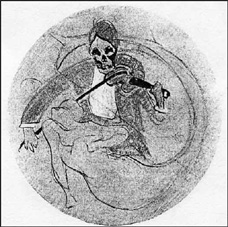
Drawing for Venereal Disease Poster Competition- 1918
In 1918 Magritte had published his first commerical advertising poster for Pot au Feu Derbaix and entered a competition to design a poster for a government campaign against venereal disease. Above is the drawing.
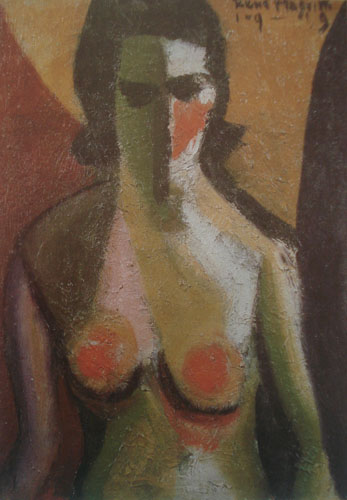
Nude circa 1919
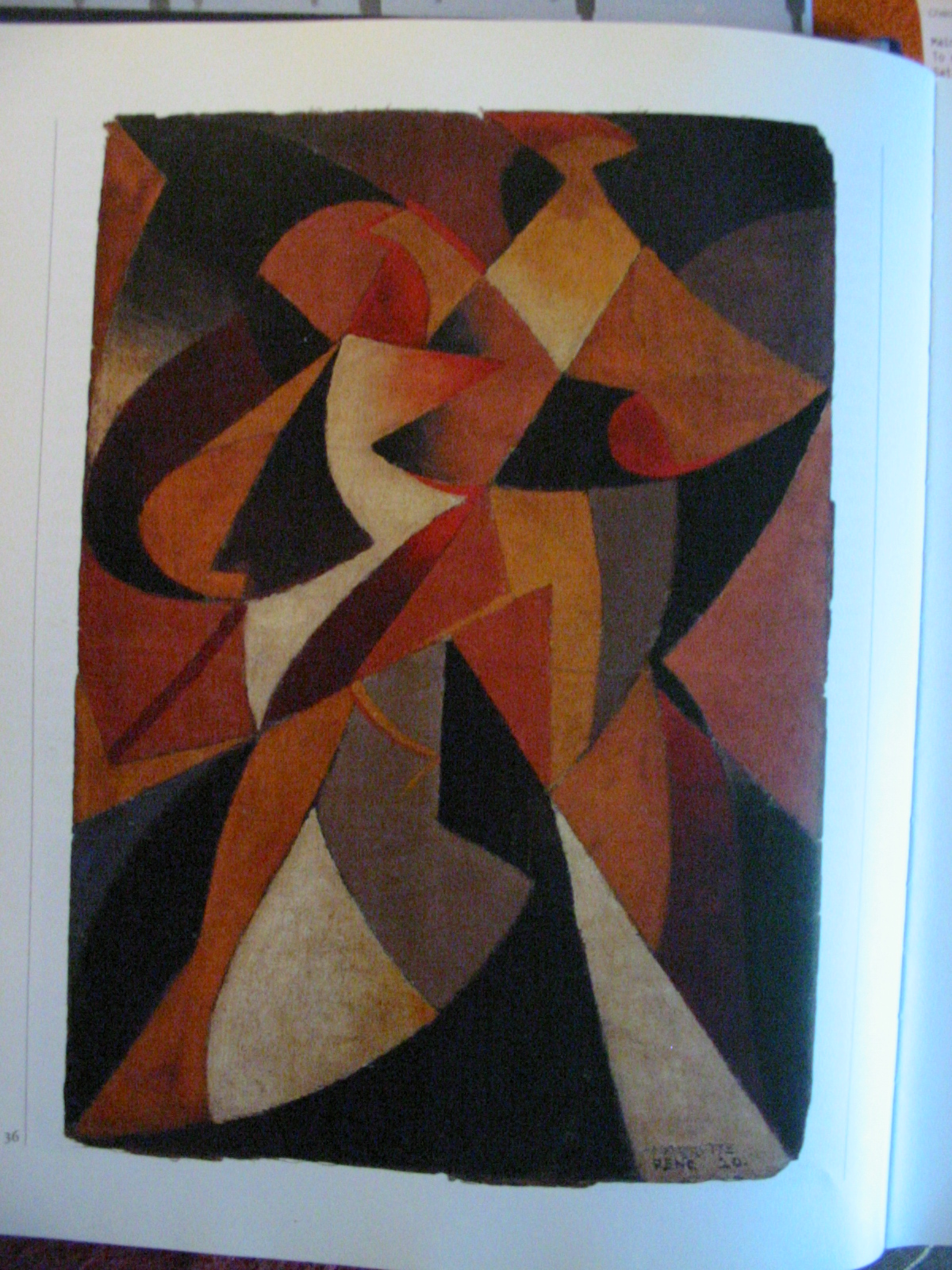
Head 1920, oil
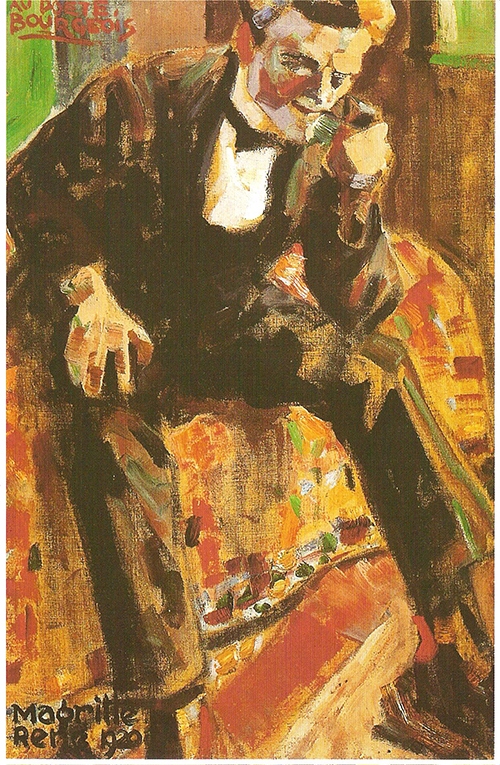
Portrait of Pierre Bourgeois- 1920
Magritte's closest friend at the Academic des Beaux-Arts was the poet Pierre Bourgeois brother of the architect Victor Bourgeois. Pierre and Rene served in the military from December, 1920 to September, 1921. Magritte was a member of the Eighth Line Regiment, stationed in both Belgium and Germany. At the Academic des Beaux-Arts they were inspired by radical contacts and acquaintances in Brussels, which were calculated to intensify both his hatred of the established order and his passion for the poetic, which was Dadaism.
Pierre Bourgeois introduced Magritte to the Futurists [Magritte claims someone anonymously left a futurist catalogue for him], whom he joined for a few years. He was far more inspired by their eroticism than by their belief in progress and the grandiose promises that technology held out for the future. It was for this reason that the poets Eduard (ELT) Mesens and Marcel Lecomte were able to so decisively support Magritte in the initial years of his development. Magritte arranged for Mesens to teach the piano teacher to his brother Paul. Mesens already held the artist's work in some esteem at an early stage, and arranged for him to have a considerable number of stimulating contacts with the Dadaist circle. Pierre along with his brother Victor, creators of the journal (magazine) Au Volant in 1919, started a new journal, the 7 Arts review in 1922 (until 1928), which also expressed Dadaist views about the arts.
Lecomte likewise felt an allegiance to Dada, for example with Clement Pensaers, who produced strange little pamphlets with such titles as "Bar Nicanor" or "Le pan pan au cul du nu negre". Magritte, discouraged by his first financial setbacks, had just started working as a textile pattern designer in a wallpaper factory under Victor Servranckx, the Cubist painter- when he met Lecomte again. Lecomte showed him the picture of a painting by de Chirico, entitled Song of Love. The painter was later to write: "That was one of the most moving moments in my life; for the first time, my eyes saw thought."
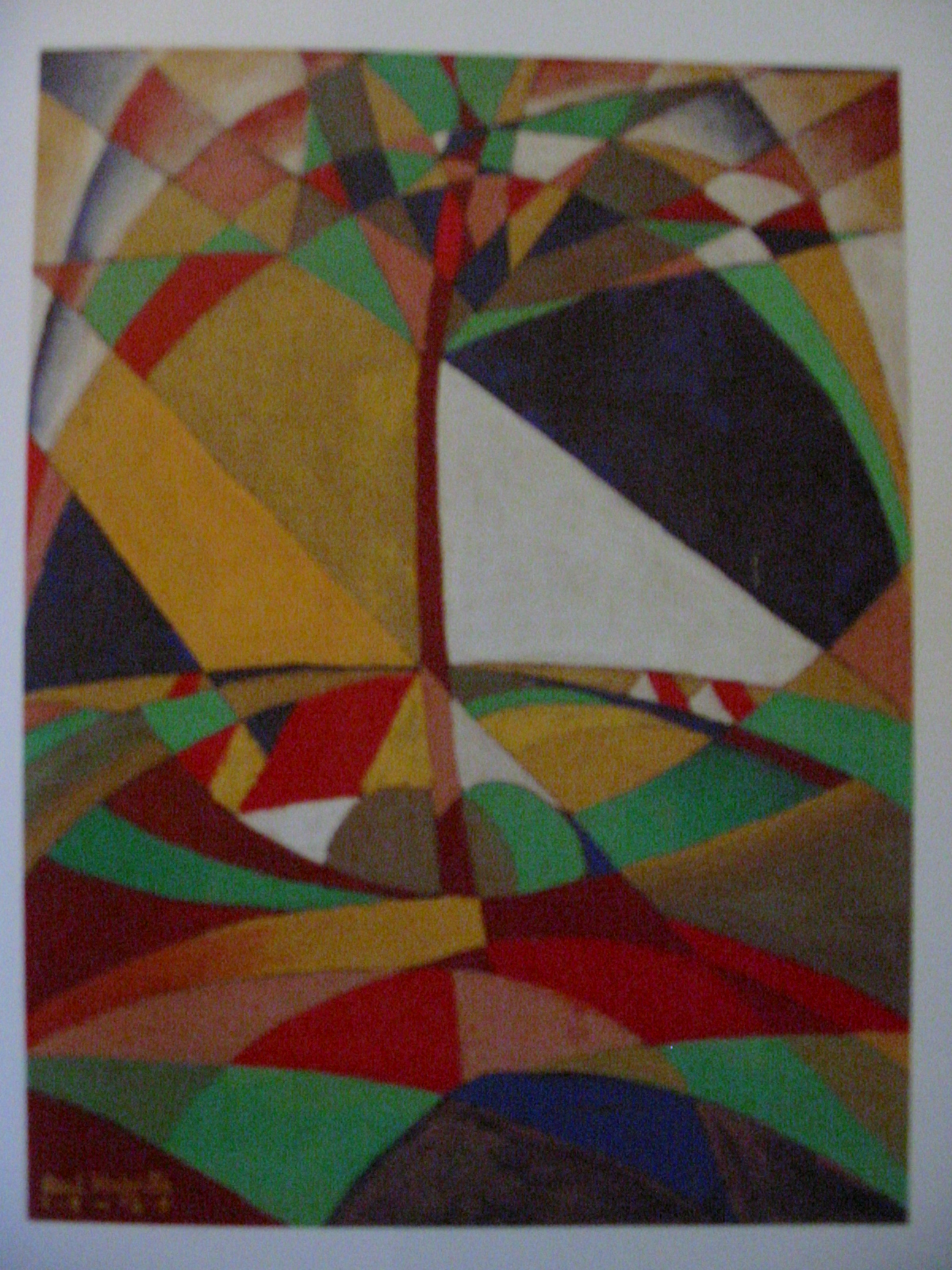
Landscape 1920 oil on Canvas

Portrait of Pierre Broodcoorens- 1921
Pierre Broodcoorens was a writer friend Magritte met at the Académie Royale des Beaux-Arts.
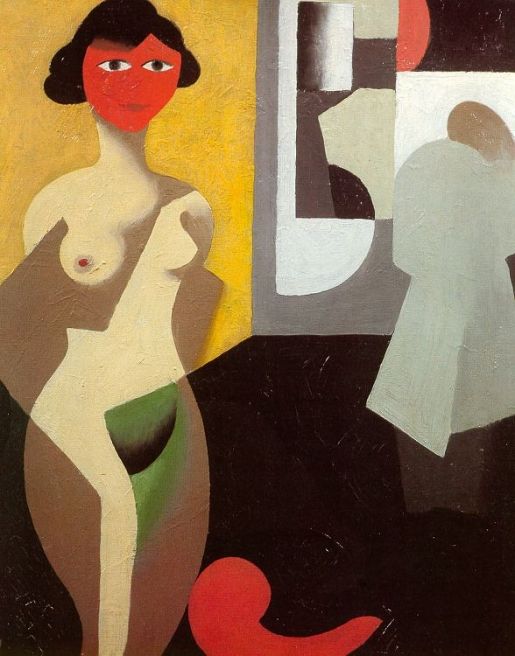
The Model (Le Modele)- 1922
%201922.jpg)
Femmes (Women) 1922
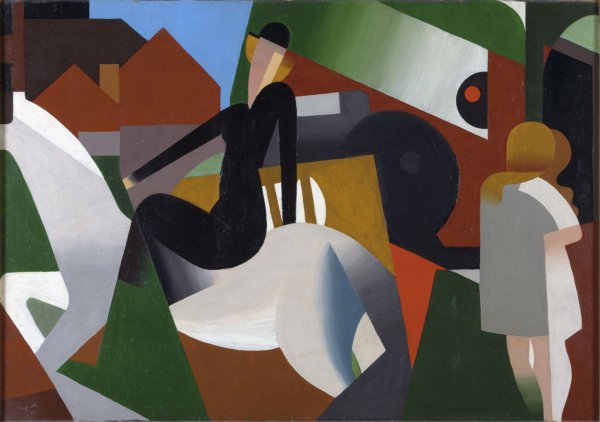
The Horsewoman (L'Écuyère) 1922
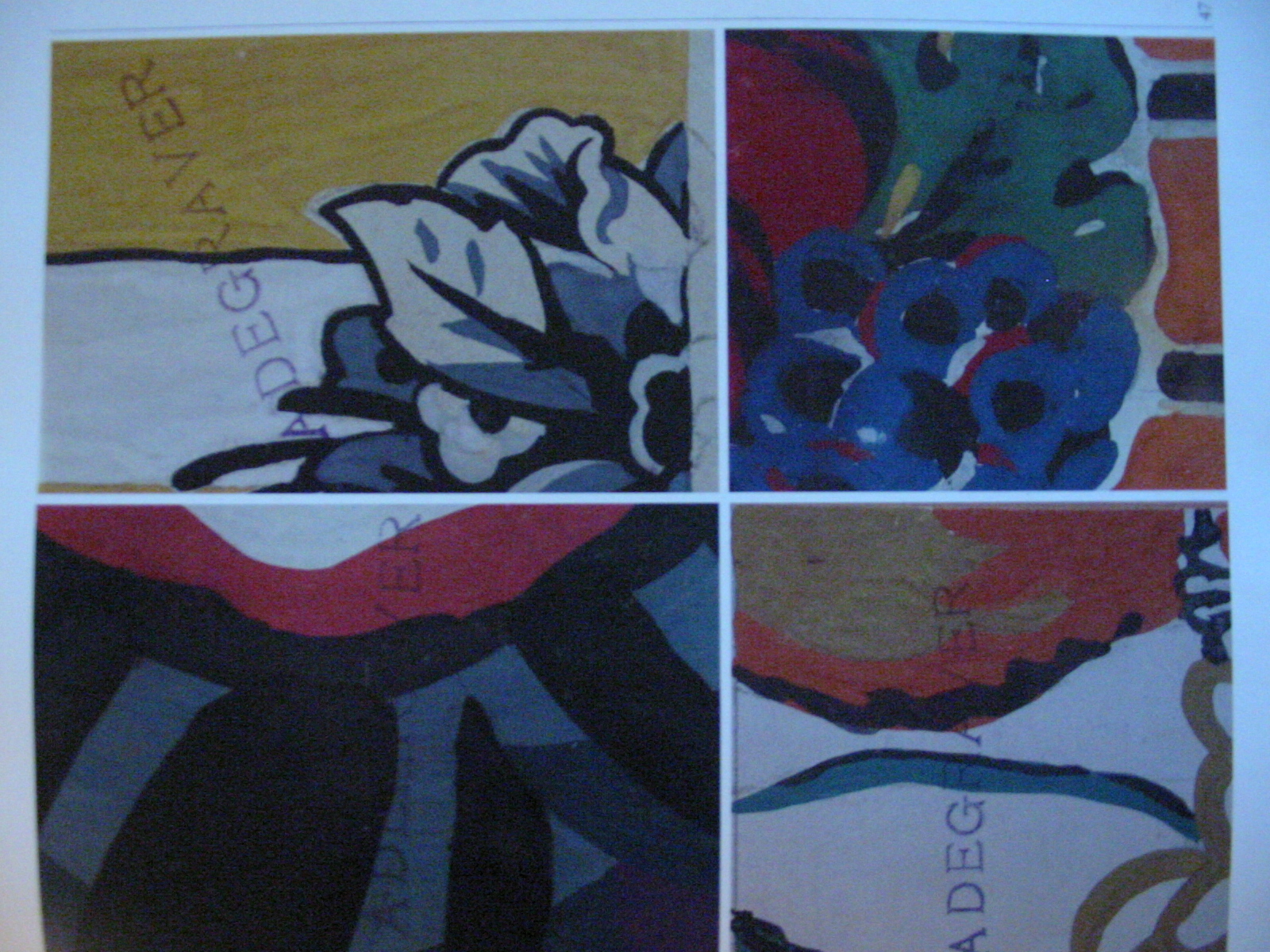
Magritte wallpaper design 1922
Rene Magritte was employed as a wallpaper designer in 1922, the same year he married Georgette.
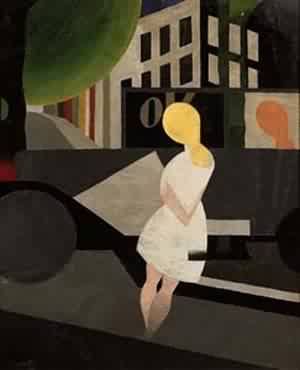
Modern- 1923
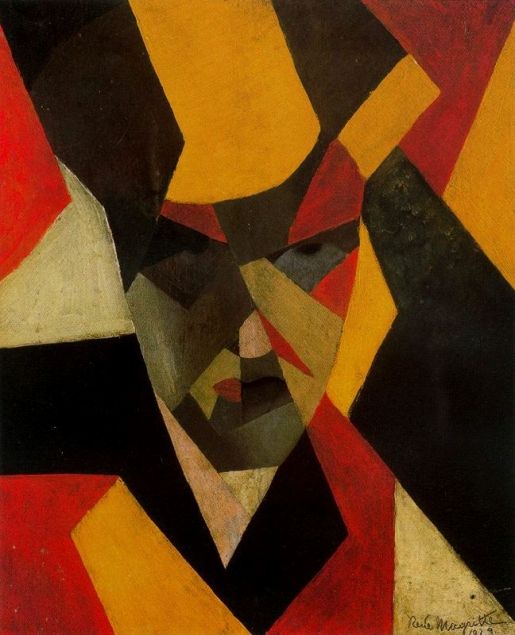
Self-Portrait 1923

Georgette at the Piano- 1923

Donna 1923
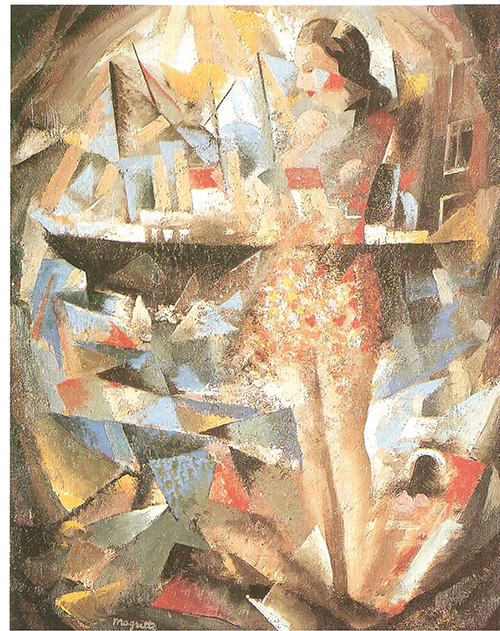
Jeunesse (Youth) 1924
This painting shows Magritte's command of futurist techniques. Magritte and ELT Mesens wrote to the leader of the futurist movement the Italian writer, Filippo Tommaso Marinetti, who sent more pamphets.

1924 Advertisment design for Alfa-Romeo: by Magritte, France, multicolor, reproduction, features fashionably dressed rail-thin models with a grand Town car featured in a cubist theme, also promotes Norine, a fashion industry leader.

1924 Drawing of Georgette, Rene's wife, model and muse
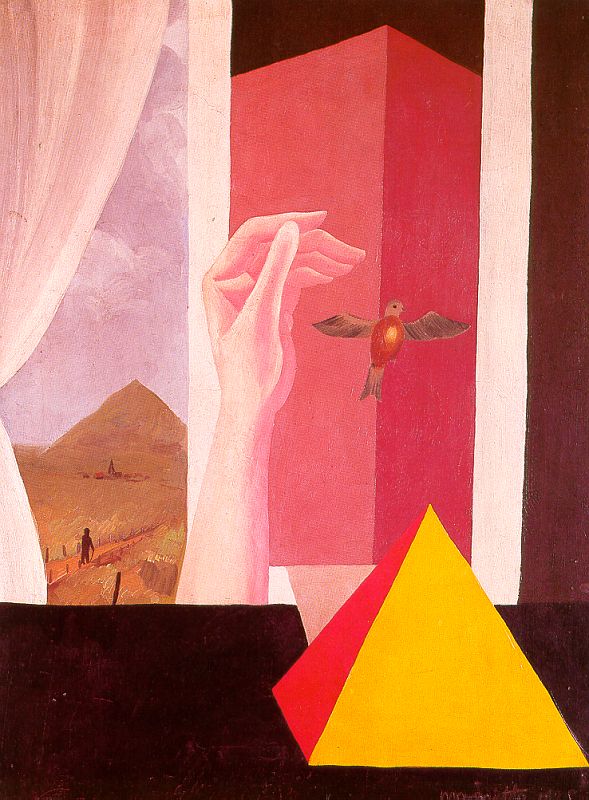
The Window 1925
Magritte is the first important painting showing his new style around 1925. The Window is an iconic (repeated) image found in many of Magritte's paintings. Here he still uses futurist/cubist forms. This shows a window seen from inside a room, with, outside the window, a hand trying to catch a bird in flight.
Hammacher p. 44: "This work was inspired by the illustration of a wall painting Max Ernst had made in 1922 for Paul Eluard's home in Euabonne."
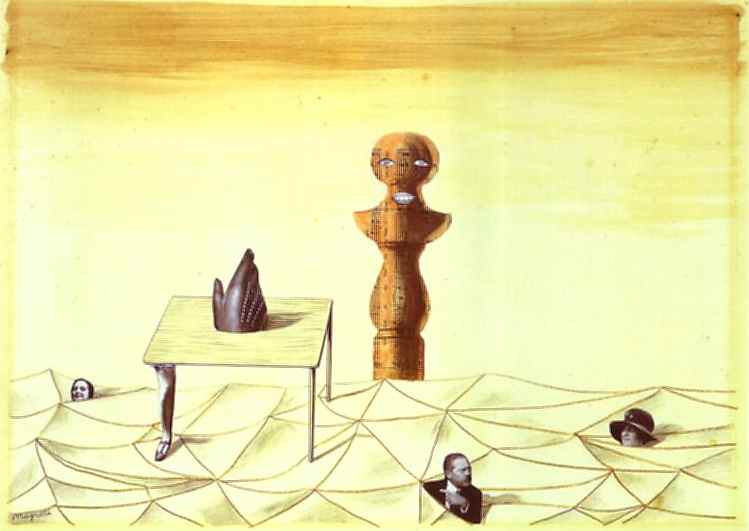
Untitled Collage circa 1925
The next two untitled collages are among Magritte's earliest and I believe pre-date the 1926 Lost Jockey. Rene was inspired by the collages of Max Ernst. According to David Sylvester, Magritte began made over two dozen collages from 1925 until he left for Paris in 1927. Note the umbrella pattern design Magritte began using in some of his early paintings and collages. Here the bilboquet has clearly taken on human characteristics. What appears to be an image of Sigmund Freud is pointing the way...but which way?
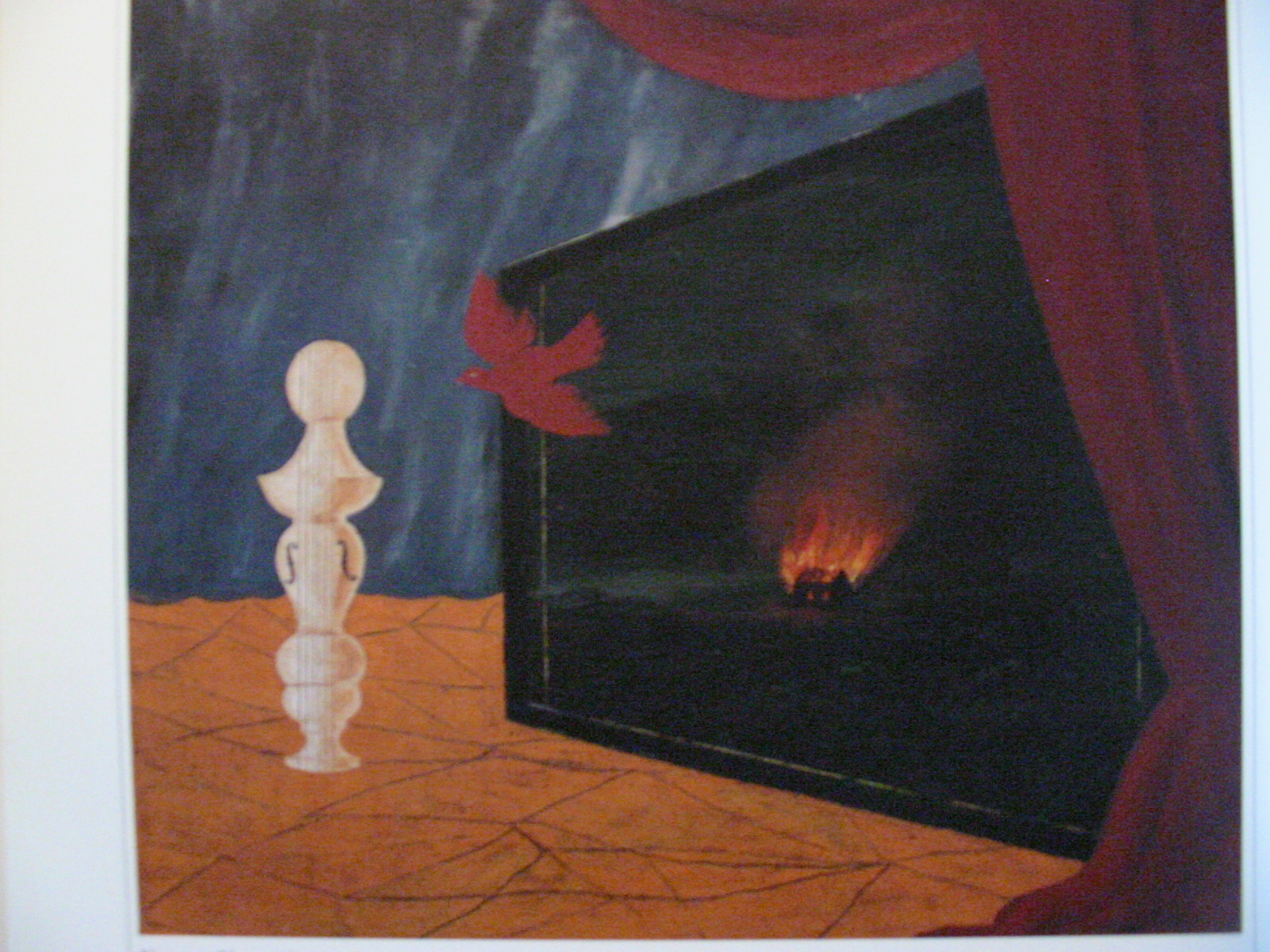
Nocture 1925
Nocturne is one of Magritte's important early paintings. It established many of Magritte's icons: the bilboquet, the spiderweb design on the floor, and the curtain. It's also the first painting within a painting, a technique he borrowed from De Chirico's 1917 "Great Metaphysical Interiors." [Sylvester]

The Two Sisters- 1925, oil
The title is a possibly reference to Georgette and her sister even though it's simple a duel portrait of Georgette with eyes open and eyes closed. The tile is a reference to Magritte's new hero, De Chirico whose painting titled "The Two Siters" Magritte was surely aware. [This is confirmed by Sylvester]
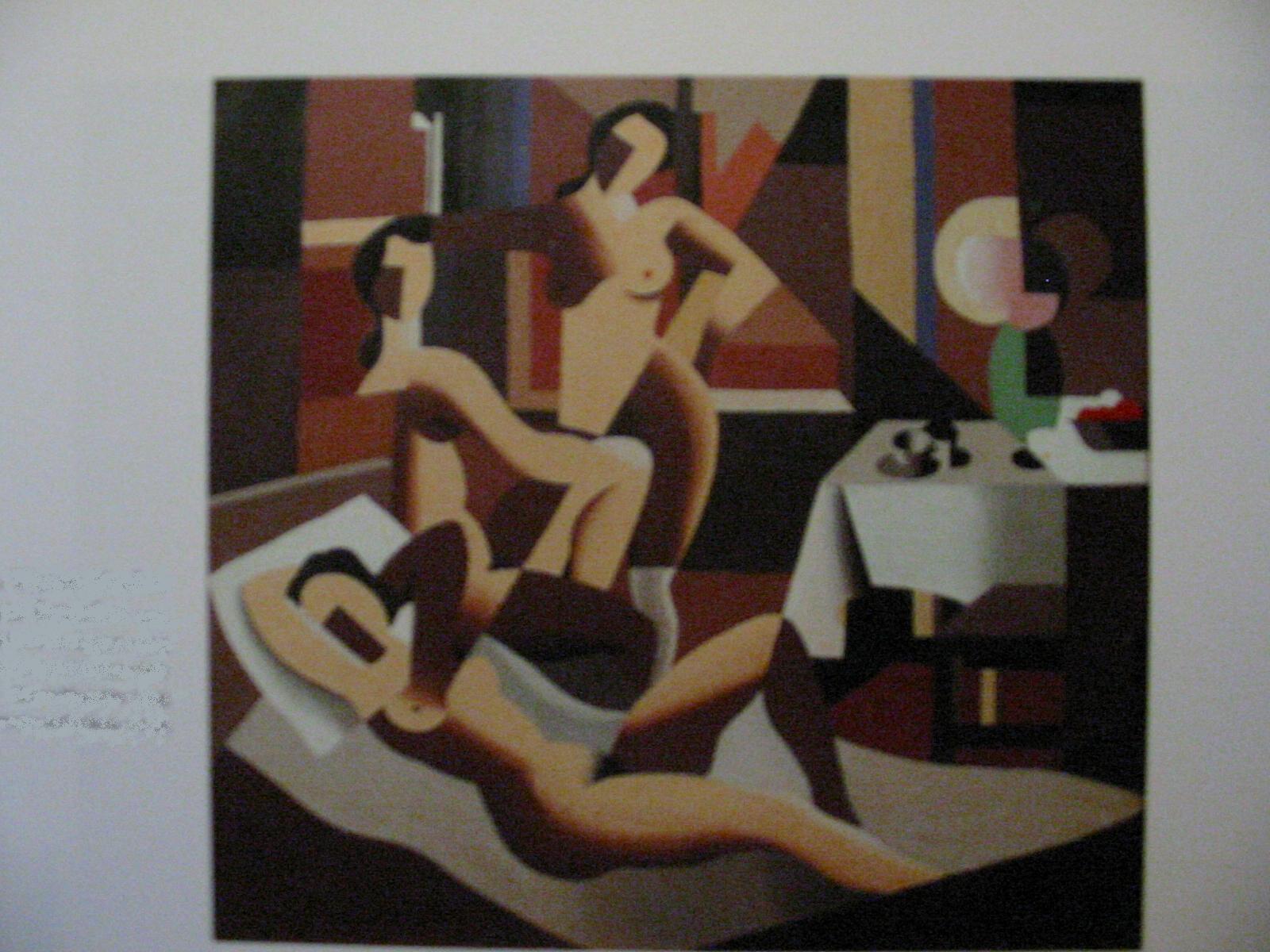
Three Nudes in an interior 1925
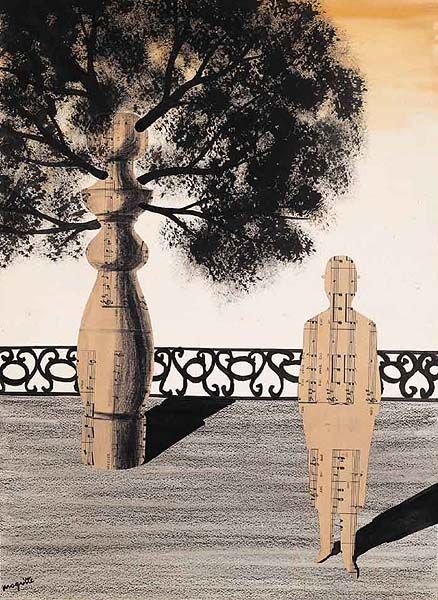
Untitled Collage circa 1925- 1926
This is a common Magritte use of musical notes in a collage probably used as a tribute to his brother Paul and close friend ELT Mesens, both musicians (ELT was Paul's piano teacher). Here the bilboquet assumes the image of a tree.
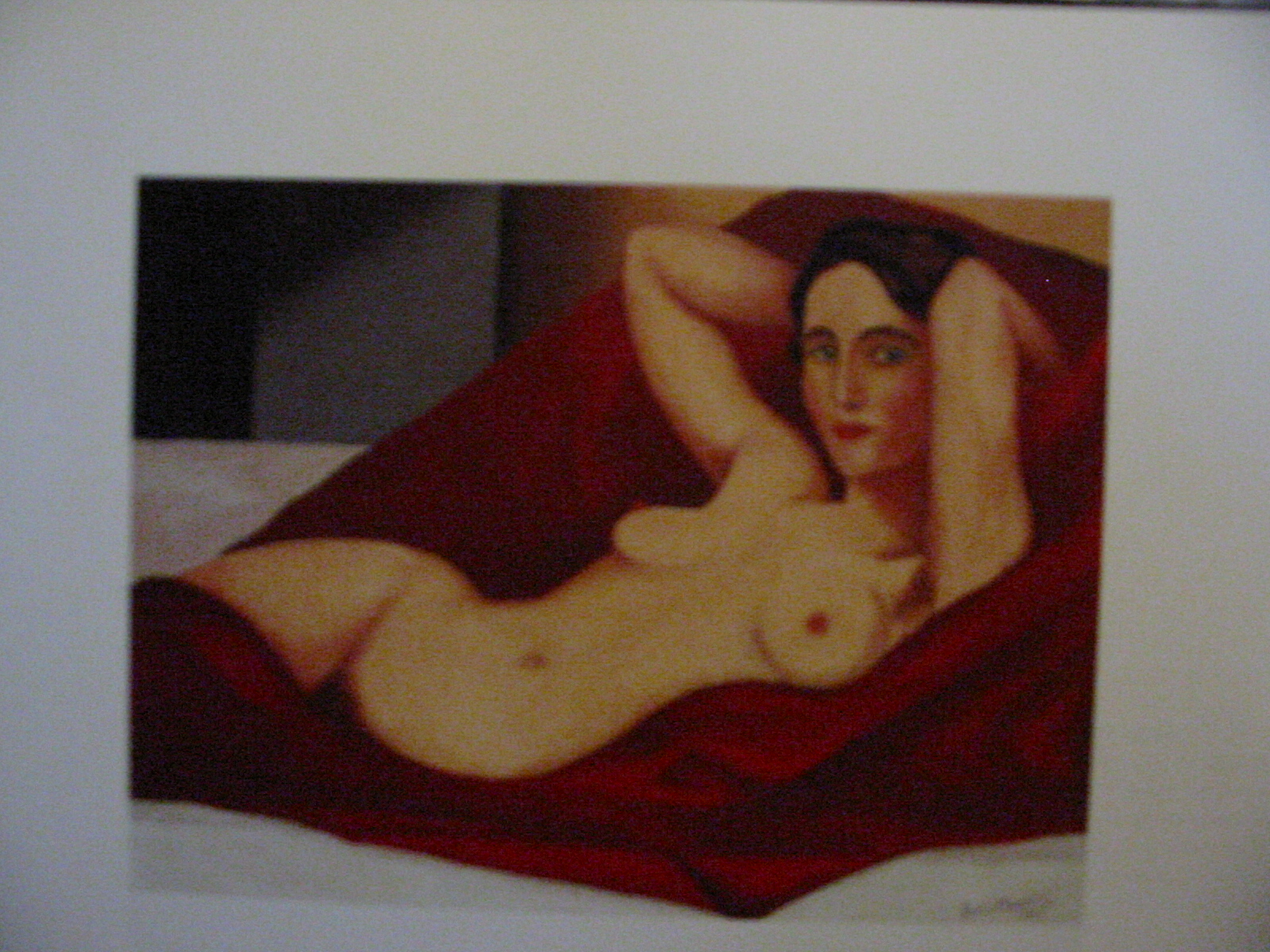
Reclining nude 1925 oil
This is certainly of the better early nudes Magritte painted of his wife Georgette.

The Bather (La baigneuse) 1925
The Bather and the Blue Cinema show Rene's evolving style towards art deco from his work as an advertiser for Norine in 1924, a leading fashion design company.
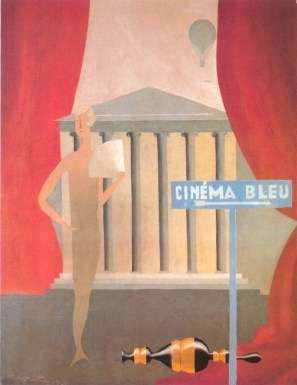
Blue Cinema (Cinema Bleu)- 1925
Cinema Bleu is one of the pivotal paintings of young Magritte's early career. Using in part the art deco style style he was developing as an ad designer for Norine he manages to distort perspective and add a few icons. The interesting aspect of the painting is that it recaptures an important event in his youth; reliving events in his life was a form of mental catharsis that helped create many Magritte masterpieces.
One of the few childhood memories as a young boy was a large manned weather balloon (as seen in the right sky) landing on the roof of the Magritte home. He reprises this event for perhaps the first time in this painting. Magritte's idol, the Italian artist de Chirico, also used ballons in his paintings. Here we find one of Magritte's first uses of the iconic bilboquet (balluster) floating horizontally at the front of the painting. The iconic curtains and stage setting is used and the pantheon type building is an impossible object existing in the distance and in front of the left curtain.